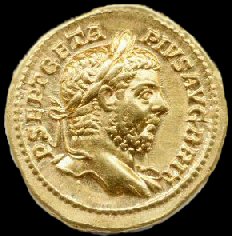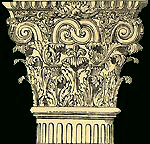|
|

R o m a n E m p i r e
Marcus Tullius Cicero (106 BC-43 BC), the well known Roman author, orator and politician, wrote:
"Let arms give place to the robe, and the laurel of the warriors yield to the tongue of the orator."
 On the right: Publius Septimus Geta, 210 A.D. © 2006 Liberty Street, used by permission) On the right: Publius Septimus Geta, 210 A.D. © 2006 Liberty Street, used by permission)
The laurel wreath has, since antiquity been regarded as a powerful symbol of victory, (and one that later evolved into the wearing of a crown). Medals symbolise a sprig of laurel because of its association with victory. It began, though, not with the Olympics, but with another Pan-Hellenic festival, the Pythian Games.
Sacred to Apollo, the Pythian Games were second only in importance to the Olympics in the eyes of the Greeks. However, the tradition of stamping the laurel wreath on coins began not in Greece, but in ancient Rome, where the Emperors had their images stamped on coins wearing wreaths on their heads.
The Roman Empire`s desire for glory pushed their army eastwards, in the direction of Persia. For centuries, every ambitious young Romans dreamt of winning a famous battle and returning home in triumph.  A Triumph was not merely a victory parade, although the successful general would ride through the streets of Rome in a chariot pulled by white horses, and wearing a laurel wreath on his head at the head of his troops. Hundreds of captives, all destined for slavery, followed behind his chariot to emphasise the largeness of his victory and power. The ostentatious parade was also an official recognition by the Roman Senate that the general had won a major victory and that, in effect, he was now a man to of considerable power in the affairs of Rome. For many a triumphant general this triumph led to a place in the Forum where he could go on to achieve great political success as well. A Triumph was not merely a victory parade, although the successful general would ride through the streets of Rome in a chariot pulled by white horses, and wearing a laurel wreath on his head at the head of his troops. Hundreds of captives, all destined for slavery, followed behind his chariot to emphasise the largeness of his victory and power. The ostentatious parade was also an official recognition by the Roman Senate that the general had won a major victory and that, in effect, he was now a man to of considerable power in the affairs of Rome. For many a triumphant general this triumph led to a place in the Forum where he could go on to achieve great political success as well.
• Top•
According to Shakespeare, (as he described it in "Anthony and Cleopatra", Act I, scene III), the word "laurel" has been symbolical even back then... Let us see what Cleopatra said to Anthony:
"And all the gods go with you! Upon your sword Sit, laurel victory! And smooth success be strew`d before your feet!"
On the left: Claudius, (10 BC -54 A.D)
The words victory and laurel were almost synonyms. Let us have a fleeting glimpse at a few visual examples, which have survived, and where the Emperors are depicted with the wreath on their head. On the left: Marcus Aurelius (A.D. 161-180) on a gold coin. In the Latin language, Aurelius means "golden". Even though he seemed to be a bringer of peace rather than a military hero, like the majority of the emperors of that epoch, he to was pictured with a wreath, as a symbol of power, victory and success. (His image is still be found stamped on the Italian euro coins) 
On the right: Antoninus Pius (A.D. 138-161) stamped on a bronze coin. During his third consulship, (A.D. 140-144) Antoninus issued a series of unusual coins and medallions, which featured entirely new or modified religious / mythological images, and which he released to prepare for the celebration of Rome`s nine-hundredth birthday. In A.D.147, additionally to the hundreds of varieties of silver denarii, Antoninus Pius also issued a huge array of bronze coins, and on all of these coins he were stamped himself, wearing the wreath.
There are countless instances as almost all the Roman emperors wore a wreath on their head, just as later on, all Kings and Queens wore a crown. However, due to copyright restrictions, and the reluctance of many museums to grant permission to reproduce these works, I am only able to display a few examples. The motif of laurel leaves was so popular back in those days that it even appeared on ancient Roman architecture. Unlike the strict structure of Greek columns, the Roman had varied depending on the epoch, tendencies and "fashion". Moreover, since the laurel, so as nature in general, had such an enormous weight, the architecture of that era has reflected it, as we can see at the example, on the right side. Unlike the strict structure of Greek columns, the Roman had varied depending on the epoch, tendencies and "fashion". Moreover, since the laurel, so as nature in general, had such an enormous weight, the architecture of that era has reflected it, as we can see at the example, on the right side.
On the right: A column from the Roman Empire epoch, beautified with the leaves.

|

